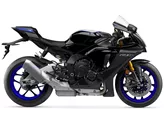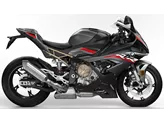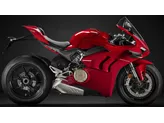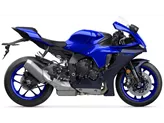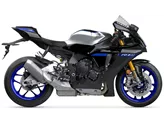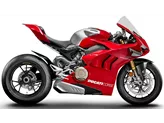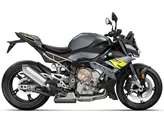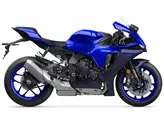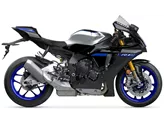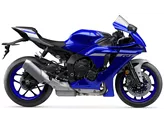BMW S 1000 RR 2019 vs. Yamaha R1 2018

BMW S 1000 RR 2019

Yamaha R1 2018
Vue d’ensemble - BMW S 1000 RR 2019 vs Yamaha R1 2018
The BMW S 1000 RR 2019 and the Yamaha R1 2018 are both high-performance supersport motorcycles that offer impressive specifications and features.
In terms of engine and drive train, the BMW S 1000 RR 2019 has a slightly larger bore of 80 mm compared to the Yamaha R1 2018's 79 mm. The stroke of the BMW is 49.7 mm, while the Yamaha has a stroke of 50.9 mm. Both bikes have a 4-cylinder engine with 4 valves per cylinder and a DOHC configuration. The BMW has a displacement of 999cc, while the Yamaha has a displacement of 998cc. In terms of power, the BMW S 1000 RR 2019 offers 207 HP, while the Yamaha R1 2018 offers 200 HP. The torque of the BMW is 113 Nm, while the Yamaha has a torque of 112.4 Nm. Both bikes have a high compression ratio of 13.3 for the BMW and 13 for the Yamaha.
In terms of suspension, both bikes feature upside-down telescopic forks in the front. The chassis of the BMW S 1000 RR 2019 is made of aluminum and has a twin-tube, load-bearing engine design. The Yamaha R1 2018 also has an aluminum frame, but it is a Deltabox design.

BMW S 1000 RR 2019
Both bikes have double disk brakes in the front for excellent stopping power. The BMW S 1000 RR 2019 offers advanced rider assistance systems such as ABS, riding modes, launch control, ride by wire, quickshifter, and traction control. The Yamaha R1 2018 also has launch control and traction control.
In terms of dimensions and weights, the BMW S 1000 RR 2019 has a front tire width of 120 mm and a rear tire width of 190 mm, both with a diameter of 17 inches. The wheelbase is 1441 mm, and the seat height is 824 mm. The kerb weight with ABS is 197 kg, and the fuel tank capacity is 16.5 liters. On the other hand, the Yamaha R1 2018 has the same tire dimensions and wheelbase as the BMW. The seat height is slightly higher at 855 mm. The kerb weight with ABS is 199 kg, and the fuel tank capacity is 17 liters.
Now let's discuss the strengths and weaknesses of each bike. The BMW S 1000 RR 2019 has a very linear power delivery, making it more controllable and faster for most riders. It has a wide rev range and pleasant dosing. The new Dynamic Damping Control (DDC) system offers precise performance. The electronics package is superb, and the shift assistant is excellent. The seating position is more active and sportier, and the bike features high-quality details such as the frame, swingarm, and display.
On the other hand, the Yamaha R1 2018 has a rev-happy engine and a great sound. It offers terrific handling and a compact and radical design while still providing great seating comfort. The electronic equipment is of high quality, and the bike features high-quality and noble components manufactured using modern methods.

Yamaha R1 2018
However, the BMW S 1000 RR 2019 does have some weaknesses. Some riders feel that it has lost a certain amount of "thrill" due to its linear power delivery. The bike may feel almost "too perfect" for some, and the menu navigation may take some time to get used to.
The Yamaha R1 2018, on the other hand, requires an agile driving style and may not be as comfortable for casual riding.
In conclusion, both the BMW S 1000 RR 2019 and the Yamaha R1 2018 are impressive supersport motorcycles with their own strengths and weaknesses. The BMW offers a more controllable and linear power delivery, while the Yamaha has a rev-happy engine and great handling. Ultimately, the choice between the two will depend on the rider's preferences and priorities.
Caractéristiques techniques BMW S 1000 RR 2019 par rapport à Yamaha R1 2018
Avantages et inconvénients en comparaison
Avantages et inconvénients en comparaison
BMW S 1000 RR 2019

La nouvelle BMW S 1000 RR 2019 est une supersports entièrement nouvelle. Elle est devenue nettement plus compacte et surtout plus légère. La machine est incroyablement facile à piloter et donne presque l'impression d'être une 600 par rapport au modèle précédent ! La position d'assise et l'ensemble des réglages de la machine sont devenus nettement plus sportifs, mais ils peuvent être appliqués sur l'asphalte de manière beaucoup plus conviviale grâce au package électronique nettement amélioré, au poids économisé et, last but not least, au déploiement de puissance presque linéaire du moteur - Bravo ! Un bémol subsiste malheureusement : si l'on veut profiter au maximum des nouveautés, il faut malheureusement cocher un maximum de cases chez le concessionnaire. Mais en contrepartie, tu peux créer ta propre BMW !
Yamaha R1 2018

La Yamaha YZF-R1 est plus proche que jamais d'une machine de course. Le moteur brille par sa légèreté et son agilité. La position de conduite surprend positivement et la maniabilité est radicale mais toujours "adaptée à la masse". La machine attire immédiatement l'attention, tant par son aspect que par sa sonorité qui fait chaud au cœur. 20 ans après la première R1, elle est désormais le plus grand jalon de l'histoire de la R1.
Comparaison des prix Prix moyen du marché BMW S 1000 RR vs Yamaha R1
There are a few key differences between a BMW S 1000 RR 2019 and a Yamaha R1 2018. There are the same number of bikes of both models available on the 1000PS.de marketplace, specifically 11. It takes less time to sell a Yamaha R1 with 52 days compared to 63 days for the BMW S 1000 RR. Since model year 2010 1000PS.de editors have written 135 reviews for the BMW S 1000 RR and 80 reviews for the Yamaha R1 since model year 2005. The first review for the BMW S 1000 RR was published on 4/16/2008 and now has more than 4,000 views. This compares to more than 3,900 views for the first review on Yamaha R1 published on 4/28/2003.





